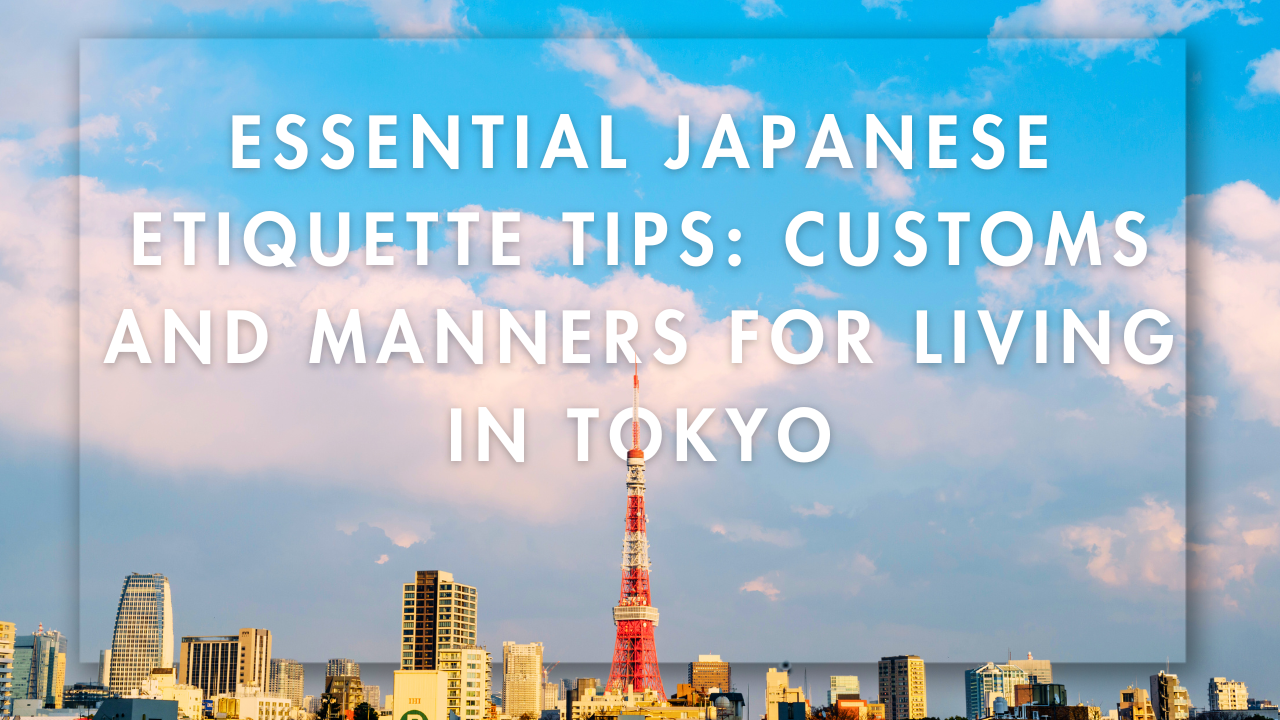Japan, a land of rich history and culture, is renowned for its intricate etiquette and customs. For those planning to live in Tokyo or even just visiting, understanding Japanese etiquette is crucial for integrating into society and showing respect to its people. This article will explore key aspects of Japanese culture, focusing on etiquette tips that will help you navigate life in Tokyo like a local.
What Are the Essential Japanese Etiquette Tips for Living in Tokyo?
How to Greet Japanese People Properly?
In Japan, greetings are an important part of everyday interactions. While in many Western countries a firm handshake is the norm, in Tokyo, the bow is the traditional greeting. Japanese people think of the bow as a sign of respect and acknowledgment. The duration and depth of a bow can vary depending on the situation; a slight nod of the head is casual, while a deeper bow shows formal respect. When meeting someone for the first time, it is customary to bow and say “Hajimemashite,” which means “nice to meet you.” Understanding and practicing this Japanese custom will help you connect with people on a deeper level.
Understanding and Using Bowing in Daily Life
Bowing is not only used for greetings but is an integral part of Japanese manners in various situations. Whether you are thanking someone, apologizing, or showing appreciation, a bow is appropriate. Learning the nuances of bowing, such as the angle and duration, is essential. Many Japanese people will appreciate the effort of foreigners who attempt to master this aspect of Japanese etiquette. It is also important to note that bowing can replace other gestures, like a handshake, in Tokyo and throughout Japan.
Tips for Navigating Tokyo’s Public Transportation with Manners
Tokyo’s public transportation system is one of the busiest in the world. To navigate it with good manners, there are several unwritten rules to follow. Eating or drinking while walking is considered bad manners, so try to finish your meals before boarding. Keeping your phone on silent and refraining from talking loudly are also expected. Priority seats are reserved for the elderly, pregnant women, and those with disabilities, so be mindful of who may need them. Many Japanese people will appreciate these small considerations, which go a long way in showing respect for Japanese society as a whole.
How to Master Japanese Table Manners and Eating Etiquette?
What Are the Do’s and Don’ts of Using Chopsticks?
Using chopsticks properly is a fundamental aspect of Japanese table manners. It is considered rude to point with chopsticks, pass food directly from chopstick to chopstick, or stick them upright into a bowl of rice, as this resembles funeral customs. Instead, place your chopsticks on the provided rest when not in use. Practicing these Japanese etiquette tips will help you avoid cultural faux pas and show respect for the dining customs. Like a local, you will be able to enjoy meals seamlessly alongside Japanese people.
Why Is It Important to Say “Itadakimasu” Before Eating?
Before eating, it is customary to say “Itadakimasu,” which translates to “I humbly receive.” This expression shows appreciation for the meal and acknowledges the effort that went into preparing it. Saying “Itadakimasu” is an important part of Japanese eating and drinking etiquette. It reflects gratitude and respect, which are core values in Japanese culture. By incorporating this phrase into your dining routine, you demonstrate your understanding and respect for Japanese customs.
Is Slurping Your Noodles Considered Good Manners?
In many Western countries, slurping noodles might be frowned upon, but in Japan, it is considered a sign of enjoyment and good manners. Slurping not only enhances the flavors of the dish but also shows appreciation to the chef. This practice is especially common when eating ramen, soba, or udon noodles. Embracing this aspect of Japanese dining etiquette will enrich your culinary experience and allow you to engage with Japanese culture more authentically.
What Are the Key Customs for Visiting Shrines and Temples?
How to Properly Cleanse Before Entering a Shrine?
Visiting a shrine or temple in Japan is a spiritual experience that requires adherence to certain customs. Before entering, it is customary to cleanse yourself at the temizuya, a water pavilion located near the entrance. Using a ladle, pour water over your left hand, then your right, and finally rinse your mouth. This ritual purification is an essential part of Japanese culture and prepares you to enter the sacred space with respect and humility.
What Is the Etiquette for Offering Prayers at Temples?
When offering prayers at a temple, it is customary to follow specific steps. Begin by throwing a coin into the offering box, bowing twice, clapping your hands twice, and then bowing once more after your prayer. This sequence is a fundamental part of Japanese religious customs, and being familiar with it shows your respect and understanding of Japanese culture. Observing these practices will enhance your experience and ensure you are respectful during your visit.
Are There Dress Codes to Follow When Visiting Religious Sites?
Dress codes are an important consideration when visiting shrines and temples in Japan. Modest attire is recommended, as these are sacred spaces. Avoid wearing revealing clothing, and if possible, wear something that covers your shoulders and knees. In some places, you may be required to remove your shoes before entering, so wearing slip-on shoes can be convenient. Understanding and respecting these dress codes is an important aspect of Japanese etiquette and will ensure a respectful visit.
How to Navigate Japanese Business Etiquette Successfully?
What Is the Proper Way to Exchange Business Cards?
Exchanging business cards, or meishi, is a significant ritual in Japanese business etiquette. When offering your business card, hold it with both hands, Japanese text facing up, and present it to the recipient. Receive the other person’s card with both hands, studying it briefly before placing it in a cardholder rather than handing it directly into your pocket. This meticulous process reflects the importance of respect and professionalism in Japanese business culture.
How to Conduct Yourself in a Japanese Business Meeting?
Japanese business meetings are often formal affairs, and certain manners must be observed. It is important to arrive on time, as punctuality is highly valued. During the meeting, be attentive and respectful, using body language to convey your engagement. Address people by their titles and last names, and wait for the most senior person to initiate the meeting. By adhering to these unwritten rules, you demonstrate your respect for Japanese customs and increase your chances of successful business interactions.
Understanding the Importance of Bowing in Business Settings
Bowing in business settings is not only a greeting but also a sign of respect and acknowledgment. The angle of the bow can convey different levels of respect—deeper bows are reserved for superiors or important clients. Practicing the appropriate body language and understanding the nuances of bowing will enhance your professional relationships and show your dedication to mastering Japanese etiquette in business.
What Are the Etiquette Guidelines for Visiting an Onsen or Hot Spring?
What Should You Know Before Entering a Communal Bathing Area?
Visiting an onsen, or hot spring, is a quintessential Japanese experience that comes with its own set of etiquette guidelines. Before entering the communal bath, it is crucial to wash and rinse your body thoroughly in the shower area. This practice ensures the cleanliness of the shared bathing area and is a fundamental part of Japanese bathing customs. Understanding these practices will help you enjoy the onsen experience fully while respecting Japanese traditions.
Why Is Showering Before Bathing in Hot Springs Important?
Showering before entering the hot spring is an essential part of Japanese etiquette, as it maintains the cleanliness and hygiene of the shared space. This practice is deeply rooted in Japanese customs and reflects the importance of respect for others. By following this protocol, you demonstrate your appreciation for the onsen culture and ensure a pleasant experience for yourself and other bathers.
Are Tattoos Acceptable in Japanese Onsens?
Tattoos in Japanese onsens can be a sensitive issue due to their historical association with organized crime. While attitudes are slowly changing, many onsens still prohibit guests with visible tattoos. If you have tattoos, it is advisable to cover them with a bandage or seek out tattoo-friendly facilities. Being aware of this aspect of Japanese culture is crucial to avoiding potential misunderstandings and ensuring a respectful visit to the onsen.




コメント